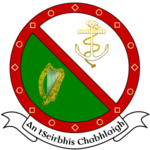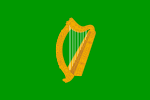- Naval Service (Ireland)
-
Naval Service
An tSeirbhís Chabhlaigh
Emblem of the Naval ServiceFounded September 1946[1] Country Ireland Branch Navy Size 1,444 personnel
8 shipsPart of Defence Forces Main naval base Haulbowline, Co. Cork, Ireland Insignia Identification
symbolLÉ Naval Jack 
The Naval Service (Irish: an tSeirbhís Chabhlaigh) is the navy of Ireland and is one of the three standing branches of the Irish Defence Forces.[2] Its main base is in Haulbowline, County Cork.
Naval Service vessels are all named with traditional Irish female names, taken from history and Celtic mythology. The ship prefix LÉ stands for Long Éireannach, "Irish ship" in the Irish language.
Contents
History
Coastal and Marine Service
The Anglo-Irish Treaty of 1921 stipulated that Ireland would be given responsibility to police its customs and fishing, while the United Kingdom would remain in control of Irish Waters. In 1923 the Coastal and Marine Service (CMS) was created, yet merely one year later it was disbanded.
During the Civil War, in August 1922, a ship belonging to the British & Irish Steam Packet Company, the Lady Wicklow, led by Captain Patrick Ryan, was used to bring Irish National Army troops around the coast to Fenit, the port of Tralee in Co. Kerry. This was probably the first naval involvement of the Irish State. Built in 1890 in Dublin Dockyard, the ship measured 262 feet by 34. 450 troops, including officers were landed. Tralee was later successfully captured from local republican forces.
The Muirchú, formerly the British armed steam yacht Helga,[3] which had been used by the Royal Navy to shell Dublin during the 1916 rising, was the only CMS ship during this period. The CMS ship "Muirchu" continued to patrol Irish fisheries. Muirchu was re-armed in 1936 and purchased by the Irish government on advice of members of the later named Maritime Institute of Ireland for fisheries protection.
In 1938 the United Kingdom handed over three "treaty" ports (Cork Harbour, Bere Haven and Lough Swilly). Consequently, the Royal Navy withdrew from Cork Harbour in July 1938. The "Fort Rannoch" was added to the Irish fleet at that time.
In 1939 the Irish Government ordered two Motor Torpedo Boats from Vospers UK. When World War II began in September 1939 the Marine and Coastwatching Service was set up. In order for Ireland to remain neutral, it became clear that a full naval service would be required. The government consequentially ordered an additional 4 MTBs. By the end of 1940 the Irish Marine and Coastwatching Service consisted of 6 MTB's and 4 other assorted craft.
During the War the Service regulated merchant ships, protected fisheries, and laid mines off Cork and Waterford. By 1941 the Marine and Coastwatching Service consisted of 10 craft (6 MTBs plus 4 assorted vessels) and about 300 all ranks. In 1942 the Service was renamed the Marine Service.
In September 1946, the Marine Service was formally disbanded and the Naval Service established as a permanent component of the Irish Defence Forces. The navy purchased three Corvettes from the United Kingdom in 1946 and 1947. The tradition of naming Irish Naval Ships after figures in Celtic Mythology began, and the ships were named Cliona, Maev and Macha. These three ships were to become a key part of the Naval Service in the 1950s and 1960s. The First formal training of Irish naval cadets took place at the Britannia Royal Naval College, Dartmouth, UK in 1947. In 1970, the Cliona and Macha were withdrawn from service and scrapped, leaving the Maev as the sole ship in the Naval Service. The Maev was withdrawn from service in 1972.[4] In 1971, the Naval Service commissioned three armed minesweepers: Grainne, Banba and Fola.
In 1971 the Naval Service commissioned Verlome Cork Dockyard to build an offshore patrol ship. Named the LÉ Deirdre, it was the first naval vessel purpose-built in Ireland to patrol its waters. The Economic Exclusion Zone of Ireland was increased in 1976 from 12 to 200 miles. The subsequent strain put on the Naval Service prompted funding from the European Economic Community to build seven naval ships, five of which remain in service today; the Mary Robinson. In 1999, a new ship LÉ Róisin was delivered to the Navy, marking the beginning of a new class of larger patrol vessels. The most recent addition to the fleet has been LÉ Niamh, commissioned in September 2001.
While most missions undertaken by the Naval Service are in Irish waters, on occasion longer missions are undertaken in support of Irish forces serving with the United Nations, representing Ireland, or in support of Irish trade missions. In 2002 LÉ Niamh delivered supplies to Irish troops in Eritrea, then continued on a trade promotional tour to India, Malaysia, Singapore, Hong Kong, China, Korea, and Japan, becoming the first Irish naval vessel to cross the Equator. In 2006 LÉ Eithne traveled to Argentina, attending ceremonies connected with the 149th anniversary of the death of Irish-born Admiral William Brown, founder of the Argentine Navy, and also visited ports in Uruguay and Brazil. In 2010, the LÉ Niamh traveled to the Americas, visiting Brazil, Argentina, Chile, Mexico and the United States.
Current strength
Its current strength is eight offshore patrol vessels:
Deirdre Class Offshore Patrol Vessels
- LÉ Emer (P21) (commissioned 1978)
- LÉ Aoife (P22) (commissioned 1979)
- LÉ Aisling (P23) (commissioned 1980)
Eithne Class Offshore/Helicopter Patrol Vessel
- LÉ Eithne (P31) (commissioned 1984)
Peacock Class Coastal Patrol Vessels
- LÉ Orla (P41) (commissioned 1985)
- LÉ Ciara (P42) (commissioned 1989)
Róisín class Offshore Patrol Vessels
- LÉ Róisín (P51) (commissioned 1999)
- LÉ Niamh (P52) (commissioned 2001)
Other Assets
The Naval Service also operates smaller training vessels and inflatable sea going craft.
Air assets are provided by the Air Corps, such as the 2 CASA CN-235 Maritime patrol aircraft operated from Baldonell Aerodrome in County Dublin.
Search and Rescue helicopters are operated under contract and are crewed and maintained by the Irish Coast Guard.
Current bases include: Cork Naval Base Headquarters, Reserve stations at Dublin, Limerick, Waterford and Cork Naval HQ. There are currently 1,444 personnel of all ranks in the service (Including aprox 400 Reserves). LÉ Eithne is the current flagship of the Naval Service.
Non-Military training takes place alongside Mercantile Marine Personnel at the National Maritime College of Ireland in Ringaskiddy, adjacent to the Haulbowline base.[6]
The Naval Service has a specialist diving unit called the Naval Service Diving Section, which was established in the 1960s.[7] They have conducted combat diving training for Ranger candidates after selecting combat diving as a specialty.[8]
Among the tasks mandated to the NSDS include the following:[7]
- Search and Recovery
- Underwater Survey
- Explosive Ordnance Disposal
- Underwater Engineering
- Military Diving Training
The future
The Naval Service is reportedly planning on replacing the LÉ Emer with an MRV (Multi Role Vessel) and the rest of the fleet in later years.[9] In 2007 it was reported that the Defence Forces expected to spend the region of €180m on an upgrade - with much of this budget to be spent on a 120 metre "enhanced naval vessel". The selected multi-role vessel would be used for coastal patrols and transport of APCs during peacekeeping deployments.[9] It was speculated that these purchases would be put on hold (due to economic conditions). However the Minister for Defence, Tony Killeen, announced in July 2010 that the Department of Defence and Naval Service would be entering into talks with UK shipbuilder Babcock Marine - to complete a deal on two new offshore patrol vessels (OPV) worth €50m each,[10] with an option for a third. The new vessels are expected to enter service 2014 and 2015, with payment expected over a number of years to 2017.[11]
Decommissioned
- Muirchú (1923–1947)
- LÉ Deirdre (P20) (1972–2000)
- LÉ Grainne (CM10) (1971–1987)
- LÉ Banba (CM11) (1971–1984)
- LÉ Fola (CM12) (1971–1987)
- LÉ Macha (01) (1946–1970)
- LÉ Maev (02) (1946–1970)
- LÉ Cliona (03) (1947–1970)
Ranks
Commissioned ranks
Insignia
- Commodore (single position)
- Captain
- Commander
- Lieutenant Commander
- Lieutenant (Naval Service)
- Sub Lieutenant
- Ensign
Non-commissioned ranks
- Warrant Officer
- Senior Chief Petty Officer
- Chief Petty Officer
- Senior Petty Officer
- Petty Officer
- Leading Seaman
- Able Seaman
- Ordinary Seaman
See also
- RACO
- Irish Coast Guard
Footnotes
- ^ The Defence Forces
- ^ The Irish Defence Forces are made up of the Permanent Defence Forces (PDF) - the standing branches - and the Reserve Defence Forces (RDF). The Naval Service is part of the PDF.
- ^ "History of the Maritime Institute of Ireland - Page 2". http://www.mii.connect.ie/history/mii/mii.html. Retrieved 2009-10-01.
- ^ RTE documentary: "The Navy"
- ^ "Ships - history", Irish Defence Forces website
- ^ NMCI - History of Nautical Training in Ireland
- ^ a b "Naval Service Specialists - Diving Section". Irish Naval Service. 2009. http://www.military.ie/naval/specialists/divers/index.htm. Retrieved 2009-10-01.
- ^ "Special Operations' Irish Army Rangers Combat Diving Page". http://www.specialoperations.com/Foreign/Ireland/Rangers/Combat_Diving.htm. Retrieved 2009-10-01.
- ^ a b "Upgrade of naval fleet to cost €180m". The Irish Times. Sat 01 Jan 2007. http://www.irishtimes.com/newspaper/ireland/2007/0106/1168032993539.html.
- ^ http://www.defence.ie/WebSite.nsf/Release+ID/135B818FAC28929080257761004496EC?OpenDocument
- ^ http://www.rte.ie/news/2010/0715/naval.html
External links
Defence Forces of Ireland Army | Naval Service | Air Corps
Army Reserve | Naval Service Reserve
Current navies in Europe Sovereign
states- Albania
- Andorra
- Armenia
- Austria
- Azerbaijan
- Belarus
- Belgium
- Bosnia and Herzegovina
- Bulgaria
- Croatia
- Cyprus
- Czech Republic
- Denmark
- Estonia
- Finland
- France
- Georgia
- Germany
- Greece
- Hungary
- Iceland
- Ireland
- Italy
- Kazakhstan
- Latvia
- Liechtenstein
- Lithuania
- Luxembourg
- Macedonia
- Malta
- Moldova
- Monaco
- Montenegro
- Netherlands
- Norway
- Poland
- Portugal
- Romania
- Russia
- San Marino
- Serbia
- Slovakia
- Slovenia
- Spain
- Sweden
- Switzerland
- Turkey
- Ukraine
- United Kingdom
- Vatican City
States with limited
recognition- Abkhazia
- Kosovo
- Nagorno-Karabakh Republic
- Northern Cyprus
- South Ossetia
- Transnistria
Categories:- Irish Naval Service
- Military of the Republic of Ireland
Wikimedia Foundation. 2010.






